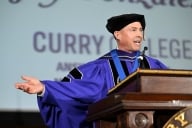You have /5 articles left.
Sign up for a free account or log in.
Through its iPod player and the iTunes Web site through which it sells individual songs, Apple has helped to change the way music is distributed. The company has grand ambitions to do the same with other kinds of content in fields like higher education, and it took another step in that direction Thursday with Stanford University’s announcement that it would make a range of audio content available to its alumni and others through iTunes.
Stanford on iTunes emerged from the longstanding collaboration between the university and Apple, which is based nearby, according to Scott Stocker, director of Web communications at Stanford.
The university had been seeking ways of giving alumni and others access to lectures and other events taking place on the campus, and in the course of continuing conversations with company officials, “there was just a very obvious marriage of the content that we wanted to make available with this wonderful technology for delivering audio content that many, many people were familiar with.”
The project has two prongs. Through the Stanford on iTunes Web site, the university will make lectures, music, sports and other content available not only to its alumni but to the public, free of charge. Stanford unveiled the site Thursday as it opened its reunion weekend, Stocker said, and alumni crowded around a campus booth downloaded music and lectures onto their iPods. “It’s already creating a lot of buzz,” he said.
The other part of the Stanford-Apple collaboration – and the one with perhaps greater implications for others in higher education – is a controlled-access Web site through which students will be able to download course materials. The restricted-access iTunes site will enable Stanford students to load course lectures and other audio content (and, eventually, video content, now that Apple is introducing a new version of iTunes that includes movies and other images) onto their iPods and listen to them whenever they wish.
“Large numbers of students are already using iPods and iTunes in their personal lives, and this is a way to use a technology they’re already familiar with to give them another way to access their course content,” Stocker said.
He said he expected Stanford to add video capabilities to its system soon, which he said could be “particularly powerful for course-related aspects, to be able to synchronize lectures and PowerPoint presentations,” for instance.
One issue down the road, Stocker acknowledged, was whether the ability to watch and listen to lectures would be so appealing that students might choose it over the real thing. “We’ll obviously have to evaluate the course use of this, to see if it does have an impact on student attendance,” he said.
Stanford joins Duke and Brown Universities and the University of Michigan at Ann Arbor’s dental school as institutions that are distributing course related content via the iTunes Music Store, according to Apple.









